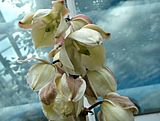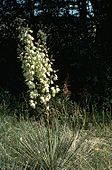Small soapweed facts for kids
Quick facts for kids Great Plains yucca |
|
|---|---|
 |
|
| Scientific classification | |
| Synonyms | |
|
The Yucca glauca plant, also known as small soapweed or Great Plains yucca, is a tough plant that stays green all year. It's great at living in very dry places, like deserts. It's called "soapweed" because parts of it can be used to make a soapy lather!
This plant grows in groups of leaves that look like a star or a rose, called "rosettes." Its leaves are long and thin, growing up to 60 centimeters (about 2 feet) long. But they are usually less than 12 millimeters (half an inch) wide. The plant also grows a tall flower stalk, which can reach up to 100 centimeters (over 3 feet) high. This stalk holds many beautiful white or very pale green flowers that hang downwards. After the flowers, the plant makes a dry fruit that looks like a capsule, filled with shiny black seeds.
Where the Yucca Lives
The Great Plains yucca is found naturally in the middle part of North America. You can see it growing from the Prairies in Alberta and Saskatchewan, Canada, all the way south through the Great Plains to Texas and New Mexico in the United States. It's a plant that loves wide-open, dry spaces!
Who Helps the Yucca Grow?
Plants need help to make seeds, and that's where pollinators come in! For the Yucca glauca, tiny creatures like the "honey ant" (Myrmecocystus mexicanus) have been seen collecting sweet nectar from its flowers. These ants, and other insects, help the plant spread its pollen so it can make new seeds.
Amazing Uses of Yucca
For a very long time, the soapweed yucca has been an important plant for many Native American tribes. Groups like the Blackfoot, Cheyenne, and Lakota used it in many ways.
The Zuni people, for example, would boil the seed pods and eat them. They also used the strong leaves to make brushes for decorating pottery and special items for ceremonies. The leaves could even be soaked in water to make them soft, then tied together to create strong ropes. Dried leaves were braided to make soft pads that people could wear on their heads to help carry heavy water pots. People also made mats and other useful items from the leaves.
The roots of the yucca were also very special. After being peeled and pounded, they would make a foamy soap! This natural soap was used to wash hair, wool clothes, and blankets. Even the young flower stalks and fruits that weren't ripe yet could be cooked and eaten.
Gallery
See also
In Spanish: Yucca glauca para niños




